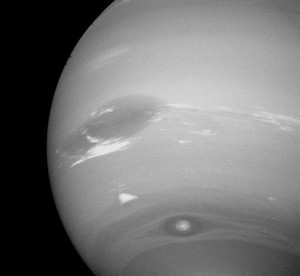The eighth planet from the Sun, orbiting every 164.79 years at a mean distance of 4498.25 million km (30.1 au). It appears distinctly blue, due to absorption of red light by methane in its atmosphere. Its mean opposition magnitude is +7.8, too faint to be seen with the naked eye. It was discovered in 1846 by J. G. Galle, after its position had been predicted mathematically by U. J. J. Le Verrier. Its shape is distinctly ellipsoidal (equatorial diameter 49 528 km, polar diameter 48 682 km). The rotation period of the visible surface varies between about 12 hours near the poles and 20 hours near the equator, but radio bursts indicate that the core rotates in 16 h 07 m.
Neptune has a thick atmosphere composed of 80% hydrogen, 19% helium, and 1.5% methane (molecular percentages). The temperature near the top of the atmosphere is around −220°C. Internally there is thought to be a small rocky core at a high temperature, probably surrounded by a layer of icy materials, and above that a layer of hydrogen and helium. The internal heat is thought to have been released by differentiation, when denser material separated out and sank to the core. Neptune has a magnetic field slightly weaker than the Earth’s, with an average strength at the equator of around 10−5 tesla. As with Uranus, the magnetic axis does not run through the planet’s core but is offset half-way to the surface, and is tilted at 47° to the planet’s axis of rotation.
Neptune
Physical data
Diameter (equatorial)
Oblateness
Inclination of equator to orbit
Axial rotation period (sidereal)
49 528 km
0.017
28°.32
16.11 hours
Mean density
Mass (Earth = 1)
Volume (Earth = 1)
Mean albedo (geometric)
Escape velocity
1.64 g/cm3
17.15
58
0.41
23.6 km/s
Orbital data
Mean distance from Sun
106km
au
Eccentricity of orbit
Inclination of orbit to ecliptic
Orbital period (sidereal)
4498.253
30.07
0.009
1°.8
164.79 years
Neptune’s atmosphere has dark belts or bands with bright zones between, similar to those on Jupiter and Saturn but fewer in number and less prominent. Dark and bright spots also occur, the most prominent being the Great Dark Spot discovered in 1989 by Voyager 2, similar to Jupiter’s Great Red Spot but not as long-lived. Another such spot appeared in 2015–16. There are also bright wispy clouds of methane ice resembling cirrus clouds on Earth, 50–100 km higher than Neptune’s main cloud tops. One of them in the southern hemisphere, photographed by Voyager 2, had a much higher velocity than other clouds and was dubbed the Scooter. Wind speeds reach 2000 km/h, faster than on any other planet.
Neptune has six rings. The Galle, Le Verrier, Lassell, Arago, and Adams rings are named after those involved in Neptune’s prediction and discovery. A sixth ring, as yet unnamed, lies along the orbit of the moon Galatea. The outer (Adams) ring has most of its matter in four bright concentrations, known as ring arcs. Neptune currently has 14 known natural satellites.
http://photojournal.jpl.nasa.gov/catalog/PIA01492
The eighth planet in average distance from the Sun. It is a giant gas (hydrogen, helium, methane) planet, with a mass 17.2 times that of Earth. It has the fastest winds in the Solar System. Its atmosphere consists mainly of hydrogen and helium but additional methane in its atmosphere gives the planet a blue colouring. Its Earth-size solid core is believed to covered by a layer of ice. The planet is surrounded by six known rings (which contain clumpy arcs of dust) and 13 known moons. Only one spacecraft has visited Uranus: Voyager 2 in 1989.

Neptune reconstructed from two images taken by the Voyager 2 probe in 1989. The Great Dark Spot is to the centre of the image, and the smaller dark spot DS2 (with its bright core) is to the bottom. Both features had disappeared by 1994. Between the two is the bright cloud feature known as the ‘Scooter’.
Credit: NASA
https://solarsystem.nasa.gov/planets/neptune/overview/ Detailed description of the planet Neptune. The site includes a chronology of the exploration of the planet, along with statistics and information on its rings, moons, and satellites, supported by a good selection of images.
The eighth planet of the solar system (formerly the ninth when Pluto’s eccentric orbit carries it inside the orbit of Neptune, but Pluto is no longer ranked as a planet). Neptune is at 30.06 AU from the Sun and between 4305.6 × 106 km and 4687.3 × 106 km from Earth. Its equatorial radius is 24 766 km; polar radius 24 342 km; volume 6254 × 1010 km3; mass 102.43 × 1024 kg; mean density 1638 kg/m3; gravity 11 (Earth = 1); visual albedo 0.41; black-body temperature 33.2 K. Neptune has a dense atmosphere, with a surface pressure greater than 100 bars, composed of molecular hydrogen (89%), helium (11%), and traces of methane, with aerosols of ammonia ice, water ice, ammonia hydrosulphide, and possibly methane ice (similar to that of Uranus). The average surface temperature is about 58 K, and winds blow at up to 200 m/s. Neptune has 14 known satellites (see neptunian satellites).
- applicative language
- applied climatology
- applied geography
- applied geomorphology
- applied mathematics
- applied meteorology
- applied microeconomics
- Applied Statistics
- Appomattox
- apposition
- apprenticeship
- approbation
- appropriate technology
- appropriation account
- appropriation bill
- approval
- approximate
- approximation
- approximation technique
- approximation theory
- appulse
- a priori
- a priori/a posteriori
- a priori (in statistics)
- AprizeSat-3 and -4